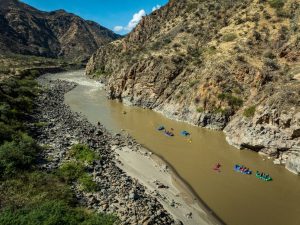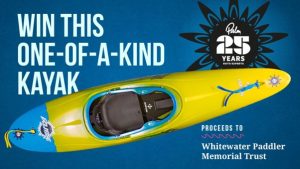
A few decades ago, women in paddlesports had to “make do”—squeezing into drysuits designed for men, battling oversized PFDs, and settling for paddles that didn’t quite fit their grip. While women’s-specific gear has existed for some time, brands now prioritise it more than ever. They’re moving beyond the old “shrink it and pink it” approach and designing with women in mind, driven by a growing wave of female paddlers who demand better.
Why the Change?
Women’s participation in outdoor sports has surged in the last decade, and paddling is no exception. This growth has driven the development of more women’s-specific gear, creating a cycle where better equipment attracts more participants, pushing brands to innovate further.
As Palm Equipment puts it:
“Everyone’s experience on the water should be safe, fun, and comfortable, which requires gear that fits well, is functional, and lasts.”
But has such equipment always been available to women, or have female paddlers had to adapt men’s gear to fit their needs?
Beyond “Shrink It and Pink It”
For years, much of women’s paddling gear was simply men’s gear in smaller sizes, designed with little input from female paddlers. The “shrink it and pink it” approach often prioritised aesthetics over performance and fit.
An example of early innovation came in 1992 when Palm developed the S PFD for a female-led expedition in the Himalayas, featuring a lower profile and advanced safety elements tailored to women’s bodies. In 1994, Kokatat introduced women’s sizing and has since built an extensive line of paddling gear, moving beyond downsized men’s patterns to designs tailored to female anatomy.


Getting the Fit Right
Brands now recognise that designing for women isn’t just about resizing gear but addressing fundamental differences in torso length, shoulder width, and hip-to-waist ratios. Pete Astles from Peak PS explains that after research showed unisex sizing didn’t accommodate the diverse shapes of female paddlers, they adjusted proportions like arm and leg length to ensure a better fit.
The Drysuit Dilemma
Drysuits highlight a particularly long-standing issue in paddling gear. Entry and relief zips are a key functional difference between men’s and women’s designs. Today, brands offer more options than ever, from front and back entry zips to front and drop-seat relief zips. However, some combinations remain limited, forcing paddlers to choose between fit and function.
Level Six recently took a data-driven approach, launching a survey to address long-standing complaints about poor fit, particularly in drysuits. The results reinforced what paddlers had long reported: fit issues are widespread, and industry-wide change is needed.
Involving Women in the Design Process
To design inclusive gear, brands should listen to all paddlers, not only pro athletes or team paddlers. Fit, functionality, and comfort vary widely, and open surveys can be a valuable way to gather broad feedback and demonstrate a real commitment to inclusivity.
Gabriella Pevec, designer at Kokatat, explains:
“We integrate real-world testing by using paddlers of different sizes, both men and women, in the patterning phase to assess fit, and specifically rely on women field testers to push prototypes to their limits.”
Do Kayaks and Paddles Need Gender-Specific Designs?
Beyond apparel, gender-specific labelling has yet to extend to kayaks or paddles. But does it need to? Manufacturers already offer a range of options, such as different paddle shafts, blade shapes, and boat sizes, allowing consumers to choose based on personal preferences. The trend towards modularity seems to address many individual differences already.

The Future of Inclusivity in Paddlesports
The growing availability of women-specific gear reflects a broader shift towards inclusivity in outdoor and paddlesports, driven by increasing participation. However, true inclusivity goes beyond equipment.
Mark Deming, chief marketing officer at NRS, explains:
“We can build on this trend by being more inclusive in brand marketing, paddling events and competitions, and the paddlesports media.”
Ensuring that all paddlers—regardless of body type, gender, age, or ability—feel represented and supported is just as important as the gear itself. Offering diverse colour options (beyond stereotypical pink) and ensuring a wide range of sizes play a role in making paddling more accessible and enjoyable for all.
Final Thoughts
This progress hinges on a balance of supply and demand. Brands need women paddlers to develop tailored gear, just as women paddlers need gear that fits them. By continuing to innovate, listen to feedback, and involve women in every aspect of the design process, brands can ensure that paddlesports remain safe, fun, and accessible for everyone.





